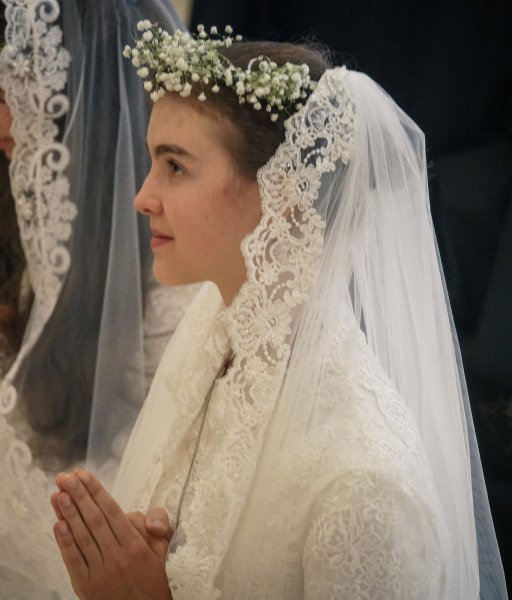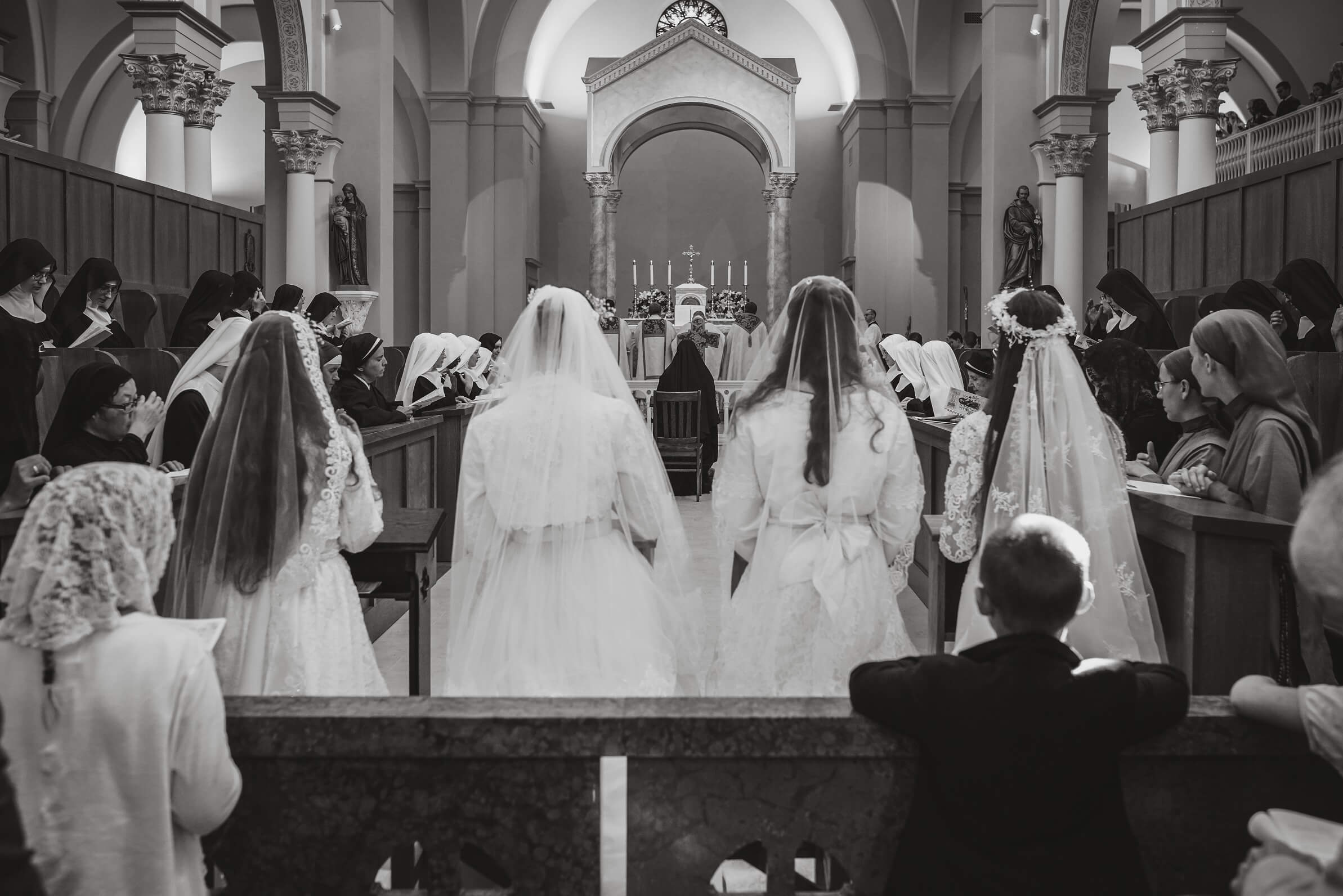I knelt right up against the rail of the transept loft, on level with the baldacchino, my back heated by the sun streaming through the rose window with the Sacred Heart. The people pressing close on either side of me stood as the nuns, walking two by two, entered the nave below. I stayed on my knees; at that angle, I could better see the door from which they came. The nuns took their places in their stalls, somehow juxtaposing the precision of soldiers manning the turrets of a fortress and the grace of birds fluttering into a dovecote. They waited in breathless silence with dancing eyes and little flickering smiles.
Then the organist struck up a mellow processional. I craned my neck a little more towards the door, my heart pounding, my hands gripping the rail before me. After a minute or two, my ears detected, singing high above the organ’s warm timbre, the cool, silvery sound of satin gliding over hardwood. First, I saw two white slippers and the white hem of a gown, then hands holding a lighted candle adorned with wild flowers and ribbons, and then the shoulders, face, and frothy white veil of the first bride. There were four of them to be invested with the habit, and my little sister came third.
 I’ll never forget my first glimpse of her. To this day, I have not seen a more beautiful bride. Her gown was simple enough, but its soft ivory tulle suited her. The lace veil affixed just above the bun on the back of her head flowed down over her shoulders and framed her steady little face. Resting on her forehead and encircling her hair was a delicate crown of Baby’s Breath.
I’ll never forget my first glimpse of her. To this day, I have not seen a more beautiful bride. Her gown was simple enough, but its soft ivory tulle suited her. The lace veil affixed just above the bun on the back of her head flowed down over her shoulders and framed her steady little face. Resting on her forehead and encircling her hair was a delicate crown of Baby’s Breath.
It was that crown that really undid me—at once a tender surprise and an utterly perfect expression of her creativity, the simplicity born of her youth, and that candid playfulness of hers that was itself profound. Materially, the crown was all loveliness, but it was this expression of the intangible, of the very heart of her who wore it, and the splendid fittingness of the beloved baby of the family wearing Baby’s Breath that made me gasp and press my hands to my mouth like a silly girl on a reality television show. How well she wore her finery! Neither vanity nor shyness tainted her gracious ease. She was regal, but indifferent, like Murillo’s young Virgin Mary who stands studiously by St. Anne’s knee in yard upon yard of lustrous satin as hovering angels hold a rose crown above her head.
My sister, Julia, was young when she entered the monastery, just recently turned seventeen. She loved to read novels, had tried to write one of her own, sang with real talent, became a decent cook, and even did a little hunting. We were the “go-getter” type of homeschoolers. She worked her summer jobs with alacrity, pocketed the expected A+ grade in Advanced Placement Algebra, and achieved a very respectable score on her ACT. Yet, it struck me that it was none of those accomplishments that she drew from on that day of days, but rather, only the old childhood proficiency at playing dress-up. And even that proficiency, she told me later, had not gone without aid. She had cajoled an older sister who worked in the sewing room into helping her sew the flower sprigs together, just as she used to cajole me into helping her with her dress-up play finery of old.
I wanted to laugh and cry with delight at God’s ways. It was His little joke on us, and she, the baby, was party to it. It was as if she and her Bridegroom had conspired together like children seeking to surprise the grownups. What a redemption of those purposeless play crowns and headdresses we used to make for ourselves down in our unfinished basement when we might have been upstairs studying or out and about racking up impressive extracurricular feats for our résumés! What vindication for those hours we seemed to have wasted!
Indeed, the more I fall in love with tradition, the more I notice the funny ways the “purposeless” and the “wasteful” have of showing up in the most solemn and climactic moments. Harkening back to childhood and beckoning on to Eternity, they tend to transcend things like Advanced Placement classes, ACTs, and that altogether dreary place people like to call the “Real World.” Of course, I don’t mean to say we should take this observation as a license to abandon our responsibilities—at least not entirely; only, let’s never abandon play entirely.
When my sister and the other brides came back from a brief disappearance in which they had exchanged their festal gowns for the somber black habits of the Benedictine order, I saw they were playing more than ever. Their smiling wimple-framed faces betrayed them as they took up once again their flower-bedecked candles. They knew the Cross and death were their lot on Earth, but they also knew that at midnight, the Bridegroom would surely come. Should we not follow them whose very lives cry out the “Hosannas!” of the Gospel children? (Matthew 21:15) Let’s die to the world more and more until, our exile spent and midnight come, we may finally, like children tripping off to play, leave the world with all its cares behind, don our heavenly finery, and go with lighted lamps to meet Our Lord.

Photos courtesy of Tracy Dunne


